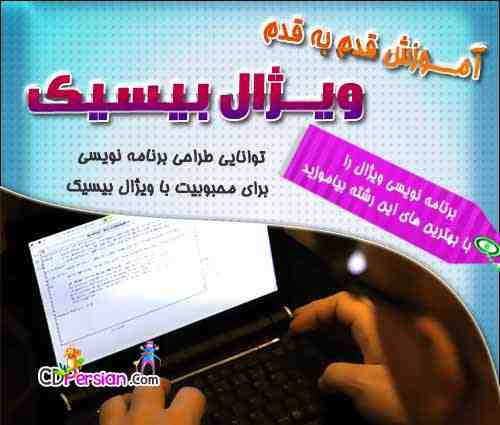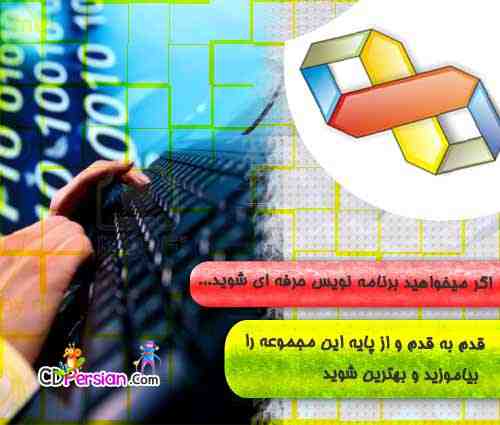| 1- درصدی از درامد فروشگاه بنیوان (سیدی پرشین سابق) هر هفته به موسسه خیریه محک اهدا میشود. شما هم در این امر خیر سهیم باشید... |
| 2- در صورت خرید هر 3 محصول، نام شما در قرعهکشی 50 محصول رایگان برای هر نفر قرار خواهد گرفت "ادامه توضیحات" |
| 3- قرعهکشی یکم هر ماه انجام میشود. برای دیدن برندگان تاریخ یکم آذر 1404 اینجا کلیک کنید. |
|
4-
در صورت داشتن هر گونه سوال، پیشنهاد، شکایت و... فقط و فقط به پیج اینستاگرام ما بروید و پس از فالو کردن، از طریق دایرکت پیام خود را بگذارید. پیج اینستاگرام ( CDPERSIAN ) فعلا تنها راه ارتباطی پیج اینستاگرام میباشد. |

آموزش قدم به قدم ویژال بیسیک 2010
ویژوال بیسیک و دنیای برنامه نویسی یکی از مواردی است که کم و بیش با آن آشنا هستید. شاید اگر با این نرم افزار مفید کار نکرده اید حداقل اسم آن را شنیده اید.
این نرم افزار توسط شرکت مایکروسافت طراحی و نوشته شده است و به دلیل توانایی طراحی برنامه در یک محیط، می توانید به خوبی با برنامه نویسی آشنا شوید.

مطالبی که در این مجموعه به آن آشنا خواهید شد به صورت مختصر نام برده شده است ::...
Table of Contents ::...
1. Getting Started with Microsoft
Visual Basic 2010
1. Chapter 1 Exploring the Visual Studio Integrated Development Environment
1. The Visual Studio Development Environment
2. The Visual Studio Tools
3. The Properties Window
4. Moving and Resizing the Programming Tools
5. Switching Among Open Files and Tools by Using the IDE Navigator
6. Opening a Web Browser Within Visual Studio
7. Getting Help
8. Customizing IDE Settings to Match Step-by-Step Exercises
9. One Step Further: Exiting Visual Studio
10. Chapter 1 Quick Reference
2. Chapter 2 Writing Your First Program
1. Lucky Seven: Your First Visual
Basic Program
2. Programming Steps
3. Creating the User Interface
4. Setting the Properties
5. The Picture Box Properties
6. Writing the Code
7. A Look at the Button1_Click Procedure
8. Running Visual Basic Applications
9. Sample Projects on Disk
10. Building an Executable File
11. Deploying Your Application
12. One Step Further: Adding to a Program
13. Chapter 2 Quick Reference
3. Chapter 3 Working with Toolbox Controls
1. The Basic Use of Controls: The
Hello World Program
2. Using the DateTimePicker Control
3. Controls for Gathering Input
4. One Step Further: Using the LinkLabel Control
5. Chapter 3 Quick Reference
4. Chapter 4 Working with Menus, Toolbars, and Dialog Boxes
1. Adding Menus by Using the MenuStrip
Control
2. Adding Access Keys to Menu Commands
3. Processing Menu Choices
4. Adding Toolbars with the ToolStrip Control
5. Using Dialog Box Controls
6. Event Procedures That Manage Common Dialog Boxes
7. One Step Further: Assigning Shortcut Keys to Menus
8. Chapter 4 Quick Reference
2. Programming Fundamentals
1. Chapter 5 Visual Basic Variables and Formulas and the .NET Framework
1. The Anatomy of a Visual Basic
Program Statement
2. Using Variables to Store Information
3. Using Variables in a Program
4. Using a Variable to Store Input
5. Using a Variable for Output
6. Working with Specific Data Types
7. Working with Visual Basic Operators
8. Working with Math Methods in the .NET Framework
9. One Step Further: Establishing Order of Precedence
10. Chapter 5 Quick Reference

2. Chapter 6 Using Decision Structures
1. Event-Driven Programming
2. Using Conditional Expressions
3. If ... Then Decision Structures
4. Select Case Decision Structures
5. One Step Further: Detecting Mouse Events
6. Chapter 6 Quick Reference
3. Chapter 7 Using Loops and Timers
1. Writing For ... Next Loops
2. Using a Counter Variable in a Multiline TextBox Control
3. Creating Complex For ... Next Loops
4. Writing Do Loops
5. Avoiding an Endless Loop
6. The Timer Control
7. Creating a Digital Clock by Using a Timer Control
8. Using a Timer Object to Set a Time Limit
9. One Step Further: Inserting Code Snippets
10. Chapter 7 Quick Reference
4. Chapter 8 Debugging Visual Basic Programs
1. Finding and Correcting Errors
2. Three Types of Errors
3. Identifying Logic Errors
4. Debugging 101: Using Debugging Mode
5. Tracking Variables by Using a Watch Window
6. Visualizers: Debugging Tools That Display Data
7. Using the Immediate and Command Windows
8. Switching to the Command Window
9. One Step Further: Removing Breakpoints
10. Chapter 8 Quick Reference
5. Chapter 9 Trapping Errors by Using Structured Error Handling
1. Processing Errors by Using the Try
... Catch Statement
2. Writing a Disc Drive Error Handler
3. Using the Finally Clause to Perform Cleanup Tasks
4. More Complex Try ... Catch Error Handlers
5. Comparing Error Handlers with Defensive Programming Techniques
6. One Step Further: The Exit Try Statement
7. Chapter 9 Quick Reference
6. Chapter 10 Creating Modules and Procedures
1. Working with Modules
2. Working with Public Variables
3. Creating Procedures
4. Writing Function Procedures
5. Writing Sub Procedures
6. One Step Further: Passing Arguments by Value and by Reference
7. Chapter 10 Quick Reference
7. Chapter 11 Using Arrays to Manage Numeric and String Data
1. Working with Arrays of Variables
2. Preserving Array Contents by Using ReDim Preserve
3. One Step Further: Processing Large Arrays by Using Methods in the Array Class
4. Chapter 11 Quick Reference
8. Chapter 12 Working with Collections
1. Working with Object Collections
2. Creating Your Own Collections
3. One Step Further: VBA Collections
4. Chapter 12 Quick Reference
9. Chapter 13 Exploring Text Files and String Processing
1. Reading Text Files
2. Writing Text Files
3. Processing Strings with the String Class
4. Sorting Text
5. Protecting Text with Basic Encryption
6. One Step Further: Using the Xor Operator
7. Chapter 13 Quick Reference
3. Designing the User Interface
1. Chapter 14 Managing Windows Forms and Controls at Run Time
1. Adding New Forms to a Program
2. How Forms Are Used
3. Working with Multiple Forms
4. Positioning Forms on the Windows Desktop
5. Adding Controls to a Form at Run Time
6. Organizing Controls on a Form
7. One Step Further: Specifying the Startup Object
8. Chapter 14 Quick Reference
2. Chapter 15 Adding Graphics and Animation Effects
1. Adding Artwork by Using the
System.Drawing Namespace
2. Adding Animation to Your Programs
3. Expanding and Shrinking Objects While a Program is Running
4. One Step Further: Changing Form Transparency
5. Chapter 15 Quick Reference
3. Chapter 16 Inheriting Forms and Creating Base Classes
1. Inheriting a Form by Using the
Inheritance Picker
2. Creating Your Own Base Classes
3. One Step Further: Inheriting a Base Class
4. Chapter 16 Quick Reference
4. Chapter 17 Working with Printers
1. Using the PrintDocument Class
2. Printing Multipage Text Files
3. One Step Further: Adding Print Preview and Page Setup Dialog Boxes
4. Chapter 17 Quick Reference
4. Database and Web Programming
1. Chapter 18 Getting Started with ADO .NET
1. Database Programming with ADO.NET
2. Using Bound Controls to Display Database Information
3. One Step Further: SQL Statements, LINQ, and Filtering Data
4. Chapter 18 Quick Reference
2. Chapter 19 Data Presentation Using the DataGridView Control
1. Using DataGridView to Display
Database Records
2. Formatting DataGridView Cells
3. Adding a Second Data Grid View Object
4. One Step Further: Updating the Original Database
5. Chapter 19 Quick Reference
3. Chapter 20 Creating Web Sites and Web Pages by Using Visual Web Developer and ASP.NET
1. Inside ASP.NET
2. Building a Web Site by Using Visual Web Developer
3. Using the Web Page Designer
4. Adding Server Controls to a Web Site
5. Customizing the Web Site Template
6. Displaying Database Records on a Web Page
7. One Step Further: Setting Web Site Titles in Internet Explorer
8. Chapter 20 Quick Reference
.jpg)
.jpg)
.jpg)
.jpg)
.jpg)
.jpg)
.jpg)
.jpg)
.jpg)
.jpg)
.jpg)
.jpg)
.jpg)
.jpg)
.jpg)










